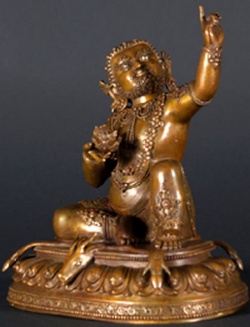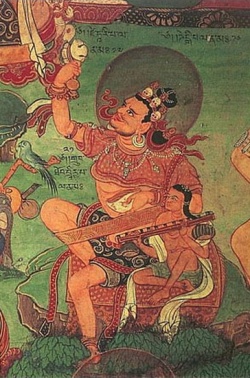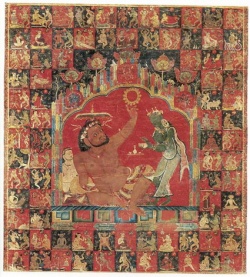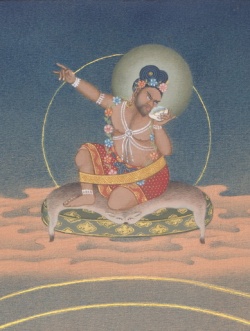The history of Mahasiddha Virupa
Mahasiddha Virupa, the Lord of all yogis, was born in a royal family in east India during the 7th-8th century CE. He later renounced the life of a prince to become a monastic. He took ordination from the abbot Vinayadeva and the teacher Jayakirti at the temple of Somapuri in India. He built a small stone temple filled with representations of the Triple Gem, which purified the obscurations of his parents.
Nalanda University
Shri Nalanda University was the most famous teaching institution at that time and was steeped in all the four schools of Buddhist philosophy. He entered the university and received complete ordination vows from the Abbot Dharmamitri of the Mulasarvastivada School. He was given the ordination name Shri Dharmapala and received Chakrasamvara pith instructions from the Abbot. He perfected an ocean-like knowledge of both Buddhist and non-Buddhist schools. His Abbot passed into parinirvana and Virupa was enthroned as Great Abbot of all pandits at Nalanda University.
Virupa maintained the practice Chakrasamvara at night, whilst teaching the Sutrayana, debating and composing Dharma texts during the day. He practised this for many years without gaining any signs or attainments. On the contrary he encountered many unfortunate circumstances and he became very discouraged with his practice.
Thinking that he had no link with the secret Mantrayana in this life, he made the decision to spend his time solely in the study and contemplation of the common vehicle. He made the pledge that from now onwards he would not teach the Dharma, compose Dharma texts, nor do any yidam practice. On the 22nd of the fourth lunar spring month (Vesak) he threw his mala into a toilet as a symbol of his abandonment of the practice and his intention to take it easy.
That very night, in a dream, he saw Nairatmaya as a blue ordinary lady who said to him, "Noble Son, please do not behave with this improper conduct. Please, retrieve your mala, wash it in perfumed water, confess your mistake and pledge not to repeat this again, and from now on uphold the practice correctly." She went on to say, "I am the deity with whom you have a karmic link. I am now bestowing blessings on you so that you will swiftly accomplish attainments." She then disappeared.
Attainments
When he awoke the following morning, Virupa was filled with great regret. On the 23rd day of the lunar month, he collected his mala and followed the instructions given in his dream. That night he perceived primordial wisdom in the form of the fifteen goddess mandala of the Nirmanakaya manifestation of Nairatmaya. The four empowerments were bestowed completely and he achieved the result of the attainment of the first bhumi (stage of enlightenment) that very night.
On the six consecutive nights, Virupa achieved increasing realisations and on the seventh night, the 29th day of the lunar month, he accomplished the sixth bhumi, gaining blessings of the four aspects of the whispered lineage.
Because he received the four empowerments completely from an unbroken lineage, the stream of initiation did not dry up.
Secondly, because he gained realisation of the first to the sixth bhumis, the stream of blessings did not decline.
Thirdly, he perfectly realised that all of his previous misfortunes were actually signs of the heat of Samadhi of the path of application. Thus the instructions were not disrupted.
Fourthly, he gained the profound confidence that his realisation was equal to that of the Buddha and completely satisfied all of his aspirations.
Strange behaviour
After this, Virupa's behaviour changed. Rumours spread in the monastery that he was taking meat and intoxicants. Some monks spying on him saw fifteen, and another monk saw one hundred women in his room, but other monks only saw fifteen or one hundred candles. Therefore there was considerable controversy. Even though he was still the Great Abbot of Nalanda University, no one had the courage to speak up.
In order to stop others despising the Buddhadharma he accepted his errors and came out of his residence and offered his robes and begging bowl to the Triple Gem. He was completely naked saying that he was ugly and took on the name Virupa, the ugly one. He began behaving oddly. He went begging flowers from flower sellers to make garlands for his head, and he went to buy radishes from a radish seller and would hold some radishes in his hands and put some in his mouth. He began frequenting pubs and brothels which shocked everyone.
The Dharma drum was sounded at the monastery to gather all the monks. It was declared that Virupa should leave the monastery and not return. Virupa made a poetic song in order to benefit the Buddhadharma and to remove beings' prejudice. He accepted his mistakes and walked towards Varanasi, crossing the River Ganges on the way.
Recognition
On arriving at the banks of the River Ganges, he said to the river, "I am the bad one, I do not want to pollute you, please give me a path". The river parted and he crossed without difficulty. Others, who had followed him, saw this and realised his enlightened qualities. Many people regretted their rejection of him and held his feet requesting that he return to the monastery. He accepted their regret, but could not agree to return to the monastery.
On reaching Varanasi, Virupa spent a long time in the forest. He became very sunburnt and weather-worn. Some people thought he was a non-Buddhist yogi, whilst others thought he was Buddhist. The Hindu King who ruled Varanasi at the time, Govindacanda, thought that if Virupa was Hindu he wanted to invite him to the palace, but if he was Buddhist, the king wanted to chase him from the kingdom. So the king ordered Virupa to be brought to the palace, so that he could decide Virupa's fate.
On the way to the palace, Virupa was seen putting whatever insects and butterflies that he came across into his mouth. This caused people (and also the insects in his mouth) to call him, "Cruel, cruel yogi". Virupa said, "Even people who kill many animals say 'Cruel, Cruel' and others who rescue beings are called, 'Cruel, Cruel', so this shows you do not understand my actions." In reality, Virupa was an enlightened bodhisattva and didn't harm any being even in the slightest way, rather he liberated these beings. He was also showing these people how to recognise their own cruelty when they made animal sacrifices.
When he met the king, who asked many questions, Virupa remained silent. The king said Virupa had no signs of a Hindu yogi and so ordered him to be bound and thrown into the river. As soon as Virupa was thrown into the river he immediately reappeared at the kings' palace. They attempted to destroy him many times in many different ways and each time he reappeared. As a result the king realised Virupa was enlightened and confessed his sins. Unshakeable devotion arose within him and in this way the entire kingdom was brought into the Vajrayana path.
Many miracles, many disciples
On the way to southern Bhimesvara, Virupa arrived at the banks of the River Ganges in order to meet a person with whom he had a karmic link. Virupa asked to be taken across the river and the ferryman asked to be paid the toll. Virupa said that he would completely satisfy the ferryman's request and asked the ferryman if he wanted the river to be larger or smaller?
The ferryman said that he would prefer the river to be smaller. Virupa pointed his index finger to the river, which then reversed. The houses on the grassy banks of the river began to subside and upstream the river began to flood, which frightened many people. The ferryman pointed to Virupa as the cause of this.
The local people then brought many offerings of cattle, crops, gold and jewels and pleaded to Virupa to stop. Virupa snapped his fingers and immediately the river began flowing normally. All of the offerings, Virupa gave to the ferryman. The ferryman refused to accept the offerings and, feeling strong devotion, fell at Virupa's feet, pleading to be accepted as his student. Virupa then returned all the offerings to the local people and everything was back to normal. The ferryman became known as Dombi Heruka, one of two foremost disciples of Virupa.
Virupa then continued his journey to nearby Bhimesvara, in Southern India at a place called Dakinitapa, where he entered a local wine shop owned by a female publican, Karmarupasiddhi. He and his disciple Dombi ordered wine but the publican asked to be paid. Virupa said that once they were satisfied, the publican would get whatever she wished. She didn't believe him and asked again when she would be paid. Virupa drew a line on the ground and said that when the shadow reaches the line, then he would pay immediately.
Virupa had stopped the sun. He leisurely began drinking and continued to drink until all the wine in the shop was consumed. The publican again wanted to know when she would be paid, but Virupa repeated that the shadow had not yet reached the line. Virupa continued to drink until all the wine in eighteen nearby towns was drunk!!
As this occurred the king's astrologers were confused; the times of everyday routines were disrupted; people couldn't cope with the lack of sleep. There was widespread chaos. The king realised that this was caused through the miraculous power of Virupa and urgently requested that he release the sun.
Virupa explained that he didn't have the money to pay the publican. The king agreed to pay the woman and then Virupa released the sun, which immediately set. It was midnight on the third day since these events began. In this way Virupa brought many people into the Vajrayana path.
Virupa had stopped the Ganges twice and also stopped the sun, causing his fame to spread far and wide. So now he continued on to Bhimesvara.
Prostrations to prajnaparamita
On reaching Bhimesvara, Virupa went to visit a non-Buddhist temple where there were five hundred long haired saddhus. Virupa praised the king, Narapati, in Sanskrit and the king was very impressed with his scholarship and appointed Virupa as the head of the five hundred yogis. Virupa maintained his personal practice, making offerings and prostrations to the prajnaparamita texts rather than to the worldly gods that the yogis revered. This generated some controversy as Virupa was not practising according to their tradition and this was conveyed to the king.
At first, the king didn't believe the yogis. He thought the yogis were jealous and that it was impossible for such a great Sanskrit scholar not to pay respect to their gods. So, the king ignored them. After many repeated complaints from the yogis the king began to have doubts about Virupa. The king summoned all the yogis to the temple asking each of them to prostrate to the image of the gods.
All of the yogis prostrated as expected, except for Virupa who continued to prostrate to the prajnaparamita texts. The king said that this is the highest of the gods of the desire realm and so Virupa should pay respect. The king demanded Virupa prostrate to their god but Virupa said he could not.
Then Virupa spoke to the statue of the god saying, "This sinful king forced me to prostrate to you, please show forbearance to me." Virupa then held his palms together at his forehead reciting, "Namo Buddhaya" and immediately one third of the statue cracked! Then he placed his palms at his throat reciting, "Namo Dharmaya," and immediately two thirds of the statue cracked! Then Virupa placed his palms at his heart and recited, "Namo Sangaya" and immediately the crack extended the length of the statue. Virupa continued to prostate to the four directions and as he did so the statue broke into four pieces.
The king and the entire retinue became very frightened. They fell at Virupa's feet requesting that he not continue. Virupa then collected the four pieces and the statue re-formed to how it was previously. Virupa then placed a statue of Avalokitesvara made of black stone on the head of the statue of the god and asked everyone to prostrate to and circumambulate it. Virupa advised them that if they did not pay due respect to this statue then it would not last. As a consequence of this miracle many people began placing Buddha images on the top of the heads of their own statues of worldly gods.
In this way Virupa demonstrated that prostrating to worldly gods can be more harmful than positive. Virupa was an enlightened bodhisattva on the sixth bhumi, which level overwhelms the power of the worldly gods.
Into the path of the Dharma
Virupa then continued further south. From amongst the 500 saddhus at Bhimesvara was Kanha, who followed him and was later to become Virupa's second foremost disciple, Krishnapa. Virupa had in fact gone there to meet Krishnapa and bring these saddhus into the Buddhadharma.
In Southern India there was a place with a statue made of red wood where, each day, hundreds of buffalo were killed and used as offerings to worldly gods. Virupa kicked the statue and asked the deity to go away. Immediately, the statue stood up and Virupa pulled him away. All the followers of the deity became frightened and begged Virupa to stop. Virupa said that if they stopped killing animals as sacrifices he would stop, but if they continued to kill innocent beings he would take this deity away. In this way, Virupa and his two followers, Dombi and Krishnapa, continued their journey together. They subdued many other worldly gods and brought an end to the killing of animals in many places.
Virupa gave Dombi, the ferryman, the blessing of the entire transmission of all of Virupa's realisation and so Dombi gained an understanding equal to that of Virupa. Virupa sent Dombi to the east of India where he subdued many beings and brought them into the path of the Dharma.
Krishnapa went with Virupa to Karsapani to meet Avalokitesvara where they performed many prostrations and paid great respect. Virupa explained to Avalokitesvara all he had done since becoming a monk up to that day, and offered this to Avalokitesvara for the benefit of the Buddhadharma. Avalokitesvara explained to Virupa, "You have great power and could turn Mount Sumeru into ashes! All sentient beings have various karmas that even the Buddha finds hard to subdue, so do not harm sentient beings and show them great compassion".
Virupa travelled to Saurastra in the west of India, where each day thousands of animals were being sacrificed to the deity Somanatha. Acting on advice from Avalokitesvara, Virupa stopped these sacrifices without destroying their statue. The devotees committed themselves to make offerings of rice and other harmless offerings in place of animals.
The spreading of Vajrayana
Virupa built a temple with a Buddha image and underneath this statue placed an image of himself. He developed a monastic community and asked the benefactors to make offerings firstly to the Buddha, secondly to the statue and thirdly to their own worldly gods. He said that if they did this, Virupa would not destroy their god but would leave it unharmed. The community requested that Virupa accept their offerings and remain for as long as Somanatha exists. Virupa blessed Krishnapa with the Vajra verses, bringing him to the same level of realisation as that of Virupa himself. Virupa asked Krishnapa to go to the eastern world to bring all beings through the Vajrayana path.
After concluding his activities at Saurastra, Virupa temporarily stopped his activities and dissolved into the stone statue, Somanatha. Virupa is believed to be in that place today and there are many accounts of miracles occurring there.
Close to this temple there is a statue of Mahasiddha Virupa. Some say it is a statue and others say it is the real Mahasiddha Virupa. He is seated in meditative posture with a philosopher's stone in his left hand that turns ordinary metals into gold. The size varies, becoming very large if not respected so that one cannot even see the head. If it is respected and offerings are made, it becomes as small as a baby and all ones wishes are fulfilled. Through the transformation into gold many beings have been brought out of poverty.
There are many stories of the many miracles performed by Virupa to attract countless beings into the Vajrayana path. The Buddhadharma greatly flourished in India as a consequence and indirectly in Tibet through the activities of his disciples. Almost all of the Buddhist traditions found in Tibet can be traced through lineages that originate in Nalanda University. Amongst the many teachers and scholars to be produced by this institution, Virupa is the foremost.
In the entire history of Buddhism there has never been another master showing such fearlessness in serving the Buddhadharma. Indeed it is said that there are three foremost great masters that followed after Gautama Buddha: King Ashoka ruled the country and through his power brought peace to the land and a flourishing of the Dharma; Dharmakirti through his logic defeated many heretical views; and Virupa through his yogic discipline subdued many distorted paths and brought many beings into the Vajrayana.



